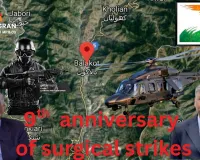Bihar Election Insight: Nitin Nabin on Highways & Development
Bihar Election special Interview
On

Nitin Nabin, Minister for Road Construction,
In recent years, Bihar has begun a dramatic transformation of its transportation infrastructure. From ageing bridges and slow rural tracks, the state is moving toward modern expressways, AI-enabled monitoring, and public-private partnership models to speed up growth and improve livelihoods. To understand what this means on the ground, we speak with Shri Nitin Nabin, Minister for Road Construction, Government of Bihar. The following Q&A touches on major expressway projects, the HAM model, innovations like AI in bridge health monitoring, challenges, and impact on farmers, businesses, and citizens.

Question . Minister, Bihar’s expressway ambitions have been talked about a lot. Which are the major expressway corridors underway or being planned, and what makes them transformative?
Answer . Bihar is moving into a new league. Some of the key expressway and road‐corridor projects include:
The Buxar-Bhagalpur Expressway route has been finalized. While originally conceived as a greenfield project, much of it will use/up-grade existing roads between Buxar, Patna, Mokama, and Bhagalpur.
The Patna-Purnia Expressway (≈ 245 km) which will pass through several districts like Vaishali, Samastipur, Darbhanga, Saharsa, Madhepura, and Purnia. It involves many bridges, interchanges, and aims to shrink travel times significantly.
Other important corridors: Patna-Arrah-Sasaram greenfield/brownfield highway, approved by CCEA under HAM model at approx. ₹3,712.40 crore.
The Raxaul-Haldia Expressway is also in the pipeline, with DPR approved and alignment work proceeding. This would connect Bihar to eastern ports and enhance trade.
Each of these expressways is transformative because they don’t just shorten distances. They improve connectivity to ports, enable smoother intra-state travel, integrate remote areas, reduce transit time and cost, and open up new economic zones.
---
Question. You’ve emphasized the HAM model (Hybrid Annuity Model). How is it being adopted in Bihar, and what are its advantages and challenges?
Answer. The HAM model is gaining ground in Bihar’s major road and expressway projects. Key points:
Several new expressways, elevated roads, and bridge projects are being structured under HAM. For example, extension of the JP Ganga Path from Digha to Koilwar via Sherpur (~ 35.65 km) is being done under HAM.
Two expressway stretches along the Ganga — one in Munger (Safiabad to Sultanganj, via Bariyarpur & Ghorghat), the other from Sultanganj to Sabour via Bhagalpur — approved under HAM, costing close to ₹9,970 crore.
The Patna-Arrah-Sasaram greenfield/brownfield corridor (120.10 km) has been approved under HAM by the Central Cabinet Committee on Economic Affairs.

Advantages of HAM:
Shares financial burden: government pays part up front, private partner contributes, so risk sharing and capital efficiency improve.
Encourages timely delivery and maintenance because private partner has long-term responsibility for upkeep.
Helps unlock projects that might otherwise be stalled due to funding constraints.
Challenges:
Land acquisition remains a hurdle—delays in obtaining land or compensating landowners can hold up work.
Getting contractors who are willing to take on risk, especially for maintenance over many years.
Ensuring quality standards in both construction and maintenance phases under HAM contracts, since the incentive structure needs to be well calibrated.
Question. The narrative you presented earlier spoke about AI-based bridge health monitoring. What is the status of that, and how is Bihar integrating tech in infrastructure safety?
Answer. Bihar has taken several steps toward tech integration:
A Bridge Health Monitoring Policy 2025 has been approved. Among its features is the use of drones, sensors, AI/ML tools to monitor the structural health of bridges.
The state government has tied up with IIT Delhi to start a six-month certification programme for more than 100 state engineers to build capacity in AI-driven bridge design, monitoring, and maintenance.
Drones are being used for periodic inspections; high-resolution imaging, thermal imaging, LiDAR etc. are involved. Also, metrics like Bridge Health Index (BHI) are being used to generate condition scores and trigger maintenance or closure when needed.
This shows that Bihar is not just building roads, but also thinking about life‐cycle costs, safety, and durability.
Question. What are some recent projects or infrastructure pieces already completed or inaugurated, showing real impact?
Answer. A few examples are:
The Aunta-Simaria Bridge (also known as Barauni-Mokama Six-Lane Ganga Bridge) has been completed around May 2025. This six-lane cable bridge (≈ 8 km including approaches) is a major connector between North and South Bihar, helping reduce travel times and easing traffic over older bridges.
Tenders have been invited for the Mokama-Munger green alignment 4-lane highway (≈ 82.40 km, NH-33), budget ~ ₹2,243.16 crore. This stretch has strategic importance as part of the Buxar-Bhagalpur corridor.
These show that many projects are moving from planning to execution to completion.
Question. What are the expected benefits to farmers, businesses, and citizens? Any quantifiable improvements?
Answer. The impact is multi-fold:
For farmers: Faster access to major markets, reduced spoilage of produce, lower freight/transport cost. Areas that were disconnected or had poor quality roads will now have more reliable access.
For businesses: Lower logistics costs, improved supply-chain efficiency. For example, expressways near or linking to ports (such as Raxaul-Haldia) reduce cost and time to move goods between Bihar, Nepal, and Bengal ports.
For daily commuters / citizens: Less travel time, better safety, improved connectivity to education, healthcare, and jobs. For instance, roads like Aunta-Simaria will cut distances for many residents. Also, with better road infrastructure, emergency services, trade, tourism can all improve.
Quantifiable gains may include reduced travel time by several hours on major expressway corridors; monetary savings in fuel, vehicle maintenance; potential uplift in property values along these corridors; increased investment in industrial parks, etc.
Question. What bottlenecks remain, and how is the government planning to address them?
Answer. Some of the major bottlenecks:
Land acquisition delays: procedural, legal, compensation. The government needs to ensure fair, transparent, timely acquisition.
Funding constraints even with HAM; in some projects initial costs (especially land, relocation) are large.
Skilled manpower for implementing advanced technologies like AI, drone monitoring, etc. Hence training programmes (e.g., with IIT Delhi) are being introduced.
Maintaining quality and ensuring maintenance over the long term: both construction quality and the upkeep of infrastructure need strong monitoring.
The government appears to be tackling these via policy reforms (digital land acquisition, transparent tendering), capacity building, stronger contractual obligations (in HAM & PPP models), and integration of technology for monitoring.
Bihar’s road revolution is more than just building blacktops; it is about connectivity, speed, safety, opportunity, and governance. By combining ambitious expressways, modern financing (HAM), and tech tools like drones and AI, Bihar is seeking to leapfrog into a more prosperous future. Challenges remain, but the momentum is real.
.....................................................................................................
#BiharExpressways
#InfrastructureRevolution
#NitinNabin
#RoadConstruction
#HAMModel
#SmartInfrastructure
#AIinBridges
#BiharDevelopment
#EconomicGrowth
#EasternCorridor
#RaxaulHaldiaExpressway
#PatnaPurniaExpressway
#BuxarBhagalpurExpressway
#TransportInnovation
#BiharTransformation
Tags:
Related Posts
Latest News
12 Oct 2025 15:56:58
Opposition parties plan on sending delegation to Ladakh after violence: Congress, CPI(M), AAP, SP, and JMM hold talks, final date...



.jpg)

1.jpg)
1.jpg)
1.jpg)

1.jpg)

